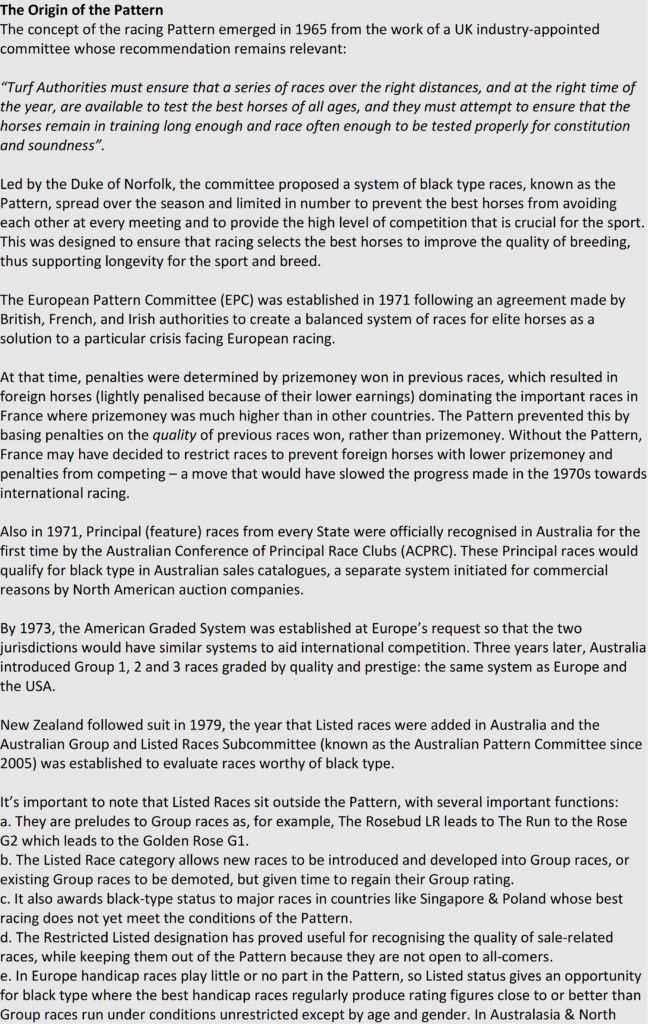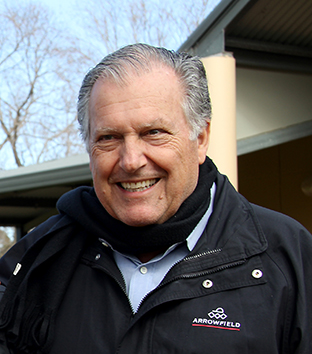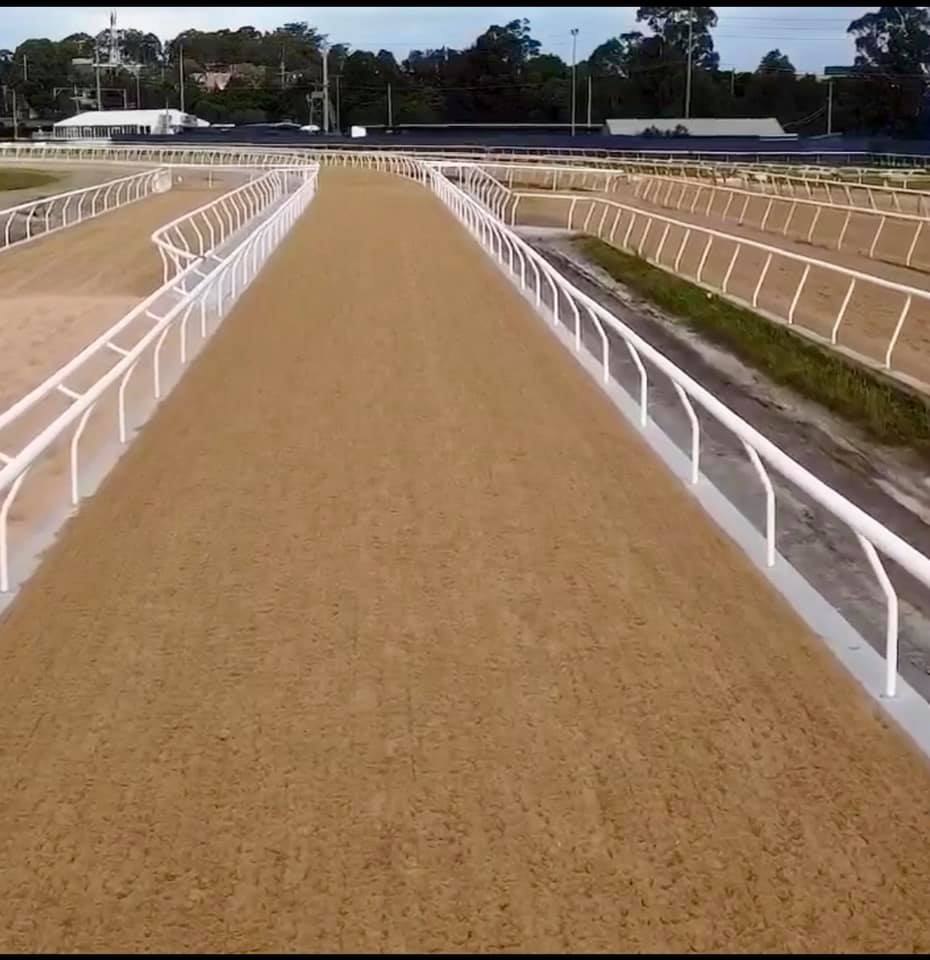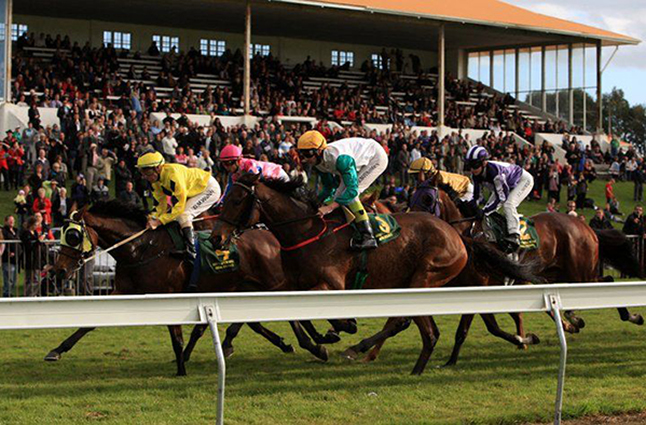The Pattern is the measuring stick by which the quality of performances of all thoroughbreds around the world are assessed, both for international and domestic comparisons and the continuation of the breed. But the introduction of sweepstakes type races has created division and put the Pattern under threat. John Messara AM has thought long and hard about its history, the introduction of races like The Everest and the future of the Pattern. He expresses his thoughts in this paper. – Brian de Lore
by John Messara
Published 18 September 2020
The Spring stakes racing program, now upon us, provides a series of escalating tests of class – collectively known as the Pattern – that deeply engage me as a sports fan who wants to see the best thoroughbreds, jockeys and trainers not only identified, but also put under pressure by competing against each other.
As the season goes on, I build up vital information about individual horses, how they compare with their peers and how they measure up against horses of previous seasons.
That information helps turn my early views about stallions, broodmares and their progeny into proper assessments based on evidence I can trust. Those assessments feed into decision making, which in turn drives our participation in the sport and investment in the industry.
Importantly, the Pattern over the years has also proved to be a valuable tool in the programming of progressive horses with options of upper and lower paths to Group 1 glory.
Leading US racing journalist the late Kent Hollingsworth said it best when he wrote in The Blood-Horse in 1974, as the international Pattern was beginning to take shape:
“Because to improve the breed, to upgrade a broodmare band, to select a stallion, to understand a catalogue page, to evaluate a family – one must be able to recognize racing class.”
That seems like a self-evident truth to me yet, forty-six years later, the Pattern is threatened in Australia and around the world by a mind-set that under-values the quest for racing excellence – for me, the ultimate Key Performance Indicator – in favour of prizemoney, wagering and entertainment KPIs. In my view none of these four objectives is necessarily incompatible with the others.
The Pattern itself was introduced as an innovative solution that would help the industry respond to the changing demands of modern racing.
There is evidence to show that Pattern Committees can facilitate innovation in race development and programming, when racing administrators see it as a valuable and flexible asset, not a set-in-concrete impediment to progress.
I find myself in agreement with Brian Kavanagh, Chief Executive of Horse Racing Ireland and Chairman of the European Pattern Committee, in his address to the 38th Asian Racing Conference earlier this year:
“Innovation is good and should be welcomed and encouraged, but it must be within a controlled environment, such as that run by the European and other Pattern Committees, and should be based on the strategic objective of improving the breed of horses or improving the race programme within a particular region.”
Mr Kavanagh went on to point to recent developments in the fillies’, sprinters’ and stayers’ programme in Europe, and support for end-of-season championships in Britain, France and Ireland.
“They were all introduced following detailed discussion and, importantly, unanimous agreement between the European Pattern countries. And further afield, innovations such as the Dubai World Cup, the expanded Breeders’ Cup programme, the Championships programme in Sydney and the upgraded Hong Kong international races programme have all been accommodated within the Pattern races of those regions.”

Progress towards consistent racing standards
A major difficulty emerged soon after the introduction of the Pattern: how to establish consistent international racing standards, so a Group 1 race in Ireland, South Africa or Australia would be of a similar standard to a Group 1 race in Japan, the United States or Brazil. A consolidated world-wide Pattern remains elusive, although progress has been made in the past decade.
What is now called the World Rankings Supervisory Committee first published international classifications of the best British, Irish and French horses in 1977 to assess quality, give breeders accurate criteria for selection and provide a method to show progression or deterioration in the breed over time.
In 1983, the International Cataloguing Standards Committee (ICSC) was set up to prevent disparities in the criteria for Group Races and black type in sales catalogues. Classifications expanded to include non-European countries to encourage international competition and a similar ratings scale had to be adopted for consistency.
Today, ‘Part 1’ countries, where races are eligible for Group/Grade status, include the USA, Canada, Japan, U.A.E, Hong Kong, Australia, New Zealand, South Africa, Brazil, Peru, Chile and Argentina. Consistency of ratings is crucial for the selection of horses for international races and assessing quality for breeding and importing, as well as to identify both national and international ‘Champions’.We at Arrowfield certainly relied on the Group 1 rating of the Haydock Sprint Cup when we acquired Danehill in 1989!
In 2011 the Australian Racing Board adopted the Asian Racing Federation’s Ground Rules, which aim to co-ordinate the assessment of Pattern races on an international level and are based on the European rules. Previously, each country within the ARF followed its own methods of upgrading, downgrading, or introducing new black type races.
The Ground Rules provide a ratings-based system for changes to the Pattern, which is applied consistently throughout Asia and Europe. These ratings are set by the World Thoroughbred Rankings Supervisory Committee, which also has members from Europe, North America and South America. In order to achieve an upgrade or prevent a downgrade, the race must improve by changing its date or conditions, or by increasing its prizemoney and the importance of a race to a club, state or sponsor can no longer over-ride these criteria.
21st century challenges & opportunities
Since its establishment, the EPC has set the bar for quality of the Pattern and its mission has set principles for the Pattern in other countries: ‘to ensure the provision of a co-ordinated programme of quality races across Europe; countries working together rather than against each other’. For this mission to succeed, consistent methods of quality control are crucial.
Re-vamped racing carnivals and the introduction of super-races have created challenges for the Pattern on a global scale. While innovation is necessary to improve participation and develop racing, it is also important to ensure that changes expand racing in a way that considers the wider industry and the long-term impact on the sport and the breed.
Five case studies illustrate the bold and creative approaches taken by racing administrators, including Pattern Committees, to develop new events for 21st century audiences and participants without throwing the Pattern out with the bathwater:
Case Study #1: Breeders’ Cup, USA
The Breeders’ Cup (BC) was created in 1984 as a championship event to attract top international horses, generate revenue, betting handle and fans. Seven brand new races worth a total of $10 million were created. The Graded Stakes committee made the unprecedented decision to grant each race Grade 1 status and again in 1999 for the new Filly and Mare Turf.
The BC aimed to provide a more logical and definitive end to the racing season. They chose a date to minimise the effect on other Pattern races while still allowing BC to be held in acceptable weather. However, many other Graded Stakes had to come forward to avoid clashing and decreasing field sizes. The New York Racing Association (NYRA) adapted their Autumn Grade 1 races including the Champagne, Man ‘O’ War and Jockey Club Gold Cup so they would become BC lead-up races. This move, to work in harmony with BC, maintained the importance of each of these Grade 1 races.
While many races successfully adapted, some existing target races suffered. Held in November over 1½ miles, the Washington D.C. International Gr.1 was North America’s first international race and had attracted the best National and European horses since its inauguration in 1952. Despite efforts to try different dates on the calendar, it was eventually discontinued in 1994 due to its decline in quality and proximity to the popular BC.
Since 1984, BC tried to create a robust series of races throughout the year by contributing funds to many US and Canadian stakes races. However, these funded races were not linked to the year-end championships. In 2007, the BC Challenge Series was created as a series of qualifiers, serving as a prelude to the BC. This ensured that the best horses in each division would have to compete against each other on all occasions on a clear pathway to the BC. This new strategy accommodated the international Pattern and built recognition for both the brand and racing throughout the year, generating more excitement, fans, and wagering, and supporting breeders and sales. The Challenge Series began with 24 ‘Win and You’re In’ races in 2 countries in 2007 and grew to 86 races in 11 countries by 2019.
The BC history since its inception shows that even the boldest innovations can be subject to challenge and review, and that working with, rather than against the Pattern can be a highly successful strategy. In 2019 five Breeders’ Cup races were ranked among the world’s top 100 Group 1 races: Classic (rated 121.5), Mile (118.5), Turf (118.25), Sprint (118) & Distaff (116.5).
Case Study #2: British Champions Day, UK
Established in 2011, British Champions Day combined two big late-season fixtures into one Championship event between the Prix de l’Arc de Triomphe two weeks earlier and the Breeders’ Cup three weeks later.
A large prizemoney boost created the richest race day in Britain but how could Champions Day fit into the Pattern, without disrupting or under-mining existing races? The answer was to re-format existing end of season target races into one meeting with increased prizemoney and new titles to attract higher quality fields and allow the races to be assessed by the Pattern committee. To complement the Pattern, the top 6 races in five categories throughout the calendar were branded as part of the Championship Series: sprint, mile, middle distance, long distance and fillies and mares.
The British Champions Day program features four Group 1 races and one Group 2 – three of them from the historical season-end program at Newmarket and two from Ascot. They became the 5 Championship races, three of them named British Champions Sprint, F&M Stakes and Long Distance Cup, with the Queen Elizabeth II Stakes & Champion Stakes retaining their original names. The use and retention of meaningful race names is a valuable tool for maintaining the Pattern’s integrity over time, and building public familiarity with the annual program of major races.
In 2019 the Champion Stakes (rated 119.75), Queen Elizabeth Stakes (117.5) & British Champions Sprint (117.25) were all ranked among the top 60 Group 1 races in the world.
Case Study #3: The Championships, Australia
In Australia, we learned from both the US and UK initiatives and ‘The Championships’ were launched in 2014 as the culmination of the Sydney Autumn Carnival. The goal was to attract top horses from around Australia and the globe, present the best racing competition at a world-class event at season’s end and provide an economic boost to racing by attracting the younger generation to the racetrack. The challenge was to create a prestigious, attractive and commercially successful event by re-shaping, not breaking or ignoring the Pattern.
Ten existing target races with well-established pathways were re-packaged into a two-day event, including 8 existing Group 1 races. Clashes with other important races were avoided, but there was a need for the addition of new races to grow the program for juvenile fillies and 3-year-old sprinters. Two existing stakes races were renamed and incorporated in The Championships program but were not awarded instant Group 1 status. Instead, increased prizemoney to attract higher quality horses was given to help those races earn Group 1 status on their merits in due course.
In 2019 both the Queen Elizabeth Stakes (rated 122) & T.J. Smith Stakes (118.5) were ranked among the world’s top 5 Group 1 races in their respective distance categories.
Case Study #4: Commonwealth Cup, UK
The Commonwealth Cup was introduced as a brand-new Group 1 six-furlong race for 3YOs at Royal Ascot in 2015, as part of a series of changes initiated by the EPC to strengthen the European sprint program. The 3YO sprint category had been under-represented, with many horses being ‘stretched out’ to try and get the mile distance of the Guineas.
Four decisions were made to make room for, and launch the race:
1. The Diamond Jubilee Stakes (same course & distance at the Royal Ascot meeting) was closed to 3YOs, encouraging them to run in the new race.
2. The Buckingham Palace Stakes was removed from the Royal Ascot meeting.
3. Geldings were allowed to compete in the first 5 runnings of the race (2015-19) – the first age-restricted Group 1 race in Europe open to geldings. (As it happened, no gelding managed to win the race in those first five years).
4. The Commonwealth Cup was also the first new race in the 44-year history of the European Pattern to go straight in with Group 1 status, rather than with a probationary period at a lower level or no grade at all. This was permitted as it related to an important European strategic initiative, rather than a single event and on the understanding that if it did not meet Group 1 parameters, it would be subject for downgrade
The Commonwealth Cup has twice been ranked among the world’s top 100 Group 1 races, in 2017 with a rating of 117.25, and again in 2019 with a 118.75 rating.
Case Study #5: The Everest, Australia
Launched in 2017 by Racing New South Wales with little reference to the Australian Pattern Committee, The Everest has been an almost instant success in terms of attracting audiences, industry backing and the best horses, and does not appear to have had a negative impact on the major weight-for-age Group 1 sprint races, notably the VRC Sprint Classic (run three weeks later) and the T.J. Smith Stakes (part of The Championships in April).
In my view, a good argument can be made for including The Everest in the Pattern because, although the method of field selection is not traditional, the slot-holders can in theory choose any horse, but are, of course, motivated by their substantial investment to select the best horses they possibly can. The proof is in the pudding: since inception the Everest has rated at Group 1 level.
Conclusion
I regard the Pattern as the bedrock of our sport because it is a time-proven system for classifying our equine athletes according to their ability that guides owners and breeders to decisions which will lead to the improvement of the breed.
The Pattern enables owners to benchmark their horses against others in their generation as well as against horses of the same age in previous generations. For many of us, aspiring to have our horse at the top of such a list is the “raison d’etre” of racing.
I applaud advances in Australia which help to make horse racing more attractive and competitive in the 21st century marketplace, such as the introduction of The Championships and the establishment of The Everest.
However, it is important for the sport that these and other initiatives find a means of meshing with the Pattern rather than disrupting it; there is too much at stake for participants in doing otherwise. Respecting the Pattern is crucial to achieve international consistency and relevance. If changes are made based on an isolated interest without considering the long-term impact on the sport and breed, we risk damaging both our national and international racing product. This obviously demands collaboration between State, National and international racing administrators willing to work in the fertile space between innovation and tradition.




